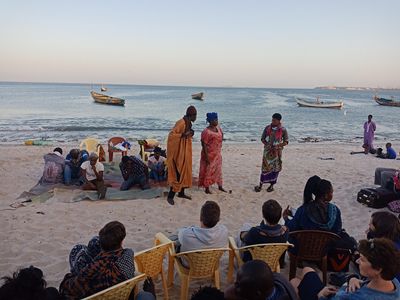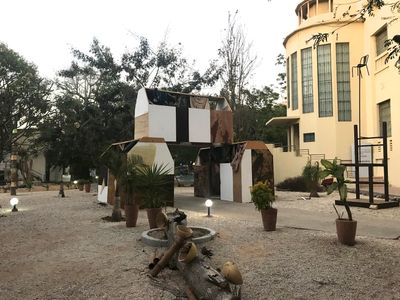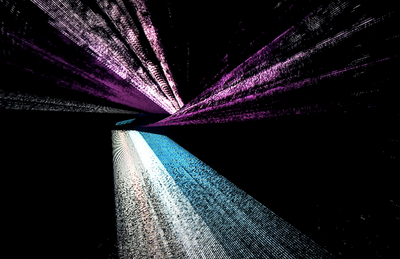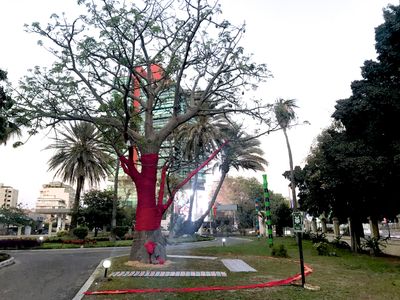Dak’Art Biennale 2018: The Red Hour
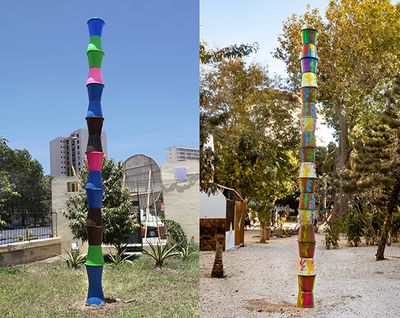
Satch Hoyt, Kush Yard Totem (2018). Eight totems and sound-scape. Installation view: Canine Wisdom for the Barking Dog—The Dog Done Gone Deaf curated by Bonaventure Soh Bejeng Ndikung, with co-curators Kamila Metwaly and Marie Hélène Perreira as part of Dak'Art Biennale: The Red Hour, Dakar (3 May–2 June 2018). Courtesy the artist.
On my last evening in Dakar, I made my way to Yarakh, a neighbourhood on the eastern side of the Senegalese capital, where I was guided down a narrow sandy path toward a beach where a group of actors, artists, and locals were taking part in or attending the performance Xeex Bi Du Jeex (a luta continua). The play was written collaboratively in 2018 by artist Raphaël Grisey, photographer Bouba Touré, and the theatre group Kaddu Yaraax as part of a long-term research project Sowing Somankidi Coura, a Generative Archive, initiated by Raphaël Grisey with the collaboration of Bouba Touré.
Touré's personal story as a migrant worker and one of the founders of the self-organised agricultural Cooperative of Somankidi Coura (CSC), serves as a template for the play's narrative. Founded in 1976 by 14 militant migrant workers within the Cultural Association of African Workers in France, the CSC supported the liberation struggles of the former Portuguese colonies and advocated for better living and working conditions of migrant workers in France.
On a piece of cloth that served as a stage, actors of the Kaddu Yaraax company, whose projects are inspired by Augusto Boal's Theatre of the Oppressed movement, improvised re-enactments in the daily lives of African workers during the workers struggle in France in the 1970s. A parallel story unfolded in Dakar, and chronicled the activities, discussions, divergent positions and internal conflicts such as, for instance, between the female and male workers of the Cooperative of Somankidi Coura. In fact, the play is the result of a two-week workshop on the history and archive of the cooperative that took place in Dakar in February 2018, and enacts a form of collective improvisation that—as poet and scholar Fred Moten writes—'correspond[s] to the necessity of paying attention to our history, to the history that we are, the history that we live.'1
A luta continua was not part of the thirteenth edition of Dak'Art (3 May–2 June 2018). But the work shares some of the biennale exhibition's themes—migration, labour, natural resources, collective forms of anti-colonial resistance—and similarly engages with the idea that re-writing history is an embodied performative act of material signification, to be collectively improvised. Titled The Red Hour after a passage from And The Dogs Were Silent, Aimé Césaire's 1956 drama celebrating revolt and decolonial politics, Dak'Art 2018 spoke of 'emancipation, freedom and responsibility.'2 It did so with an international exhibition curated by artistic director Simon Njami, presenting the works of 75 African and international artists at the old Palais de Justice, alongside a rich programme of approximately 250 'off-site' exhibitions, performances, interventions and events around and beyond the city of Dakar. Five guest curators—Alya Sebti, Bonaventure Soh Bejeng Ndikung, Marisol Rodriguez, Cosmin Costinas and Marianne Hultman—were also invited to stage an autonomous exhibition each.
What united all components of Dak'Art 2018, as the reference to Césaire's play suggests, was an exploration of how artistic practices respond to the challenges of our contemporary world, and experiment with new forms of resistance. The 'Red Hour' is the time of cultural and political awakening—'a process that entails a disconnection with or undoing of the image we have of ourselves', Njami writes. This process of dis-othering, as the curator argues, 'brings other colours and voices into the world'—he insists on the experimental dimension of artistic practices, stating: 'only experimentation can build theories of reality'.3
For The New Humanity, Njami showcased a heterogeneous group, including Glenda León, Katia Kameli, and Guy Woueté. Curiously, the exhibition title recalls Harald Szeemann's 2001 Venice Biennale titled Platea dell'Umanità, when Szeemann called for an understanding of his Biennale as 'an act of responsibility toward history' and 'the events of our times'.4 But if the Swiss curator celebrated difference as central to 21st-century globalisation, Njami's The New Humanity, inspired by Frantz Fanon's idea of the 'new' man, refuses globalisation as a homogenising force and considers it instead as the sole 'product of the other's gaze'.
Taking art as a place to experiment with a new sense of collectivity by critically rewriting shared histories, Njami's show included works like Nathalie Anguezomo Mba Bikoro's installation Triumph of Seagulls (2016). Printed on a series of white fabric kites floating above viewers' heads are the faces of women warriors from Namibia and the Congo: an homage to those who took part in the anti-colonial resistance movements organised between Berlin, Namibia and Cameroon between 1885 and 1945. Below the kites, a monitor plays the video We Built the Kilimanjaro (2016), showing a group of women squatting at Berlin's Victory Column, which the artist has used to speak of Germany's colonial empire after the 1884–1885 West Africa Conference, organised by Europe's colonial powers in order to divide Africa among them. In the video, the women whisper to each other, sharing personal stories of invisibility and/or colonial violence, in a gesture of re-appropriation and re-signification of the Victory monument's history.
This simple yet powerful gesture celebrates all women who supported and actively contributed to anti-colonial resistance movements without being documented as makers of history. But as the artist has also mentioned, the work is also a critical commentary on the ambiguous role that women play in Aimé Césaire's And the Dogs Were Silent, which inspired Dak'Art 2018's curatorial theme. In Césaire's text, women are portrayed as liars, the artist notes. (She cites the quote: 'the whore lying on her own decay, crawling on its hands without any wish to pierce the sky with a posture of protest.'5) If the 'Red Hour', as Njami emphasises, is the hour of political and cultural awakening, then Bikoro's work makes clear that a new humanity can only emerge when the role of women in the anti-colonial movement is fully acknowledged.
Indeed, rewriting history is also an act of un-forgetting. Next to Bikoro's installation was Nigerian artist Ndidi Dike's Mano Labour (2017–2018): a series of cream-coloured tulle and latex cloths hanging over a patch of rust-red sand on which old industrial printing plates and drift wood are placed. The work is dedicated to the millions of lives that have been lost due to the violent exploitation of natural resources across Africa. The latex represents the colonial history of rubber farming in the Democratic Republic of the Congo during King Leopold II of Belgium's violent reign between 1885 and 1908. The same rubber is used to make the safety gloves worn by coast guards and volunteers today in order to protect themselves from direct physical contact with refugees.
Also exploring the legacies of colonialism and their impacts on contemporary culture was Dana Whabira's Black Sunlight (2017), which speaks of the colonial repression of the indigenous Shona language in Zimbabwe, and reflects on how ideas of African nationalism were often invoked to justify totalitarian regimes across the continent. Written in neon and suggesting the Shona pronunciation of the sentence, is the phrase: 'It's not the end of the world'. The letter 'L', which is absent from Shona, has been blackened so that the sentence reads: 'It's not the end of the word.'
A series of video-excerpts from an interview with Dambudzo Marechera, the author of the experimental novel Black Sunlight (1980), accompanies the neon text. When it was first released in the early 1980s, Black Sunlight was banned by the Zimbabwean government on charges of 'Euromodernism' and as a challenge to the newly independent country. Like Marechera's novel, which tells the story of a guerrilla group in revolt against a military-fascist opposition, Whabira's conceptual piece gestures, in an ironic manner, towards a culture of hybridity, represented by the work of Marechera, which would supplant cultural nationalisms.
The current challenges faced by contemporary African cultures, and the connections between them, were expanded on in Canine Wisdom for the Barking Dog—The Dog Done Gone Deaf, curated by Bonaventure Soh Bejeng Ndikung with co-curators Kamila Metwaly and Marie Hélène Perreira. Hosted in the annex spaces of the IFAN Museum (l'Institut Fondamental d'Afrique Noire) and the Goethe-Institut Senegal, the show pays tribute to the extraordinarily rich practice of Egyptian-born American composer, ethno-musicologist and educator Halim El-Dabh, who travelled to Congo, Ethiopia, Mali, Nigeria, Sudan and Senegal among other places, and whose music is influenced by African rhythms and music cultures. A group of 13 artists from across the African continent, from Ibrahim Mahama to Elsa M'Bala and Leo Asemota, were invited to engage in conversation with El-Dabh's work.
Next to archival material documenting El-Dabh's extraordinary career—including scores, notes, personal documents and a listening station—were newly commissioned works. Emeka Ogboh's video Untitled (2018) departs from El-Dabh's experimentations with Colour Music Paintings to create a visual rendition of the album that inspired the exhibition, The Dog Done Gone Deaf, by using Alexander Scriabin's clavier à lumières (keyboard with lights) colour system. Installed in a darkened room on the ground floor of IFAN, El-Dabh's layered mystical electronic composition, played through loudspeakers, and was visually translated into a growing, wildly expanding pool of blending bright colours.
Several audio-installations occupied the garden of the museum, transforming the space into a heterogeneous sonic-scape made of passages and interruptions. Kush Yard Totem (2018) by Satch Hoyt comprises eight totems made out of coloured plastic buckets. Each totem is animated by the sound of pouring water, evoking, as the artist explains, the passage of water from one vessel to another.
Tsi I Ge Ge Ha He (Tree Shrine) (2018), by Pungwe, the interdisciplinary duo Memory Biwa and Robert Machiri, consists of a trunk of a baobab tree wrapped in red cloth, symbolising passage in many African spiritual practices, encircled at its base by sand and pieces of cloth, transforming the tree into a shrine-like audio station. Visitors could sit and listen to a polyphonic composition broadcasted through a system of speakers and megaphones installed at the base and among the branches of the tree, produced by mixing Robert Machiri's archive of mbira sounds with Memory Biwa's archive of khoekhoegowab tales. As Machiri said in conversation, this practice of remixing is a way of extending an existing composition. The tree becomes a vessel, a passage between two or more states, where the spiritual, the bodily, the political and the sonic interlace.
Also at IFAN was The Long Green Lizards, a survey curated by Costinas, director of Para Site, and EVA International 2018 curator Inti Guerrero, addressing the extraction of resources; it included Cian Dayrit's striking tapestry Yuta Nagi Panaad (Promised Land) (2018), which colourfully maps the present violence of extraction in Mindanao, Philippines, and Nicolàs Guillén Landrian's film Coffea Arábiga (1968), a gem of Cuban cinema that takes to task Fidel Castro's industrialisation of coffee plantations. On the same floor but in an adjacent space, was the ambitious Invisible, curated by director of ifa-Galerie Berlin, Alya Sebti. Staged as a series of temporary darkened 'chambers', Invisible focuses on rituals and 'invisible' knowledges that guide us through our daily life. Here, Younes Baba Ali's beautiful video Daily Wrestling (2018) offered a reflection of life on the streets of Dakar.
A performative rewriting of history implies an act of remixing, or as Pungwe explains in a note included in the press material of the show, of 'dubbing ideas from one location over those of another'—thus presenting an identity in flux. The exhibitions in this edition of Dak'Art seemed to engage in a rewriting of history that felt performative and rooted in collective practices of experimentation and improvisation. Likewise, the works on show seemed to embody composer George E. Lewis' description of improvisation—in his essay 'Improvising Tomorrow's Bodies: The Politics of Transduction'—as the 'exploration, discovery and response to conditions, part of a ubiquitous human practice of real-time analysis, generation, manipulation, exchange and transformation of meaning, mediated by (among other factors) the body, history, temporality, space, memory, intention, material culture, and diverse methodologies.'6
As a biennale institution, Dak'Art itself embodies the condition of improvisation that Lewis describes, too. Established in 1990, the Biennale is dedicated to highlighting and expanding the notion of what constitutes African identity today through culture and the arts. Over the years, Dak'Art has undergone several transformations and restructuring; today it is not one big exhibition, but rather a series of exhibitions and events that animate the Senegalese capital for a month.
One should not forget that behind the success of this edition is the struggle that it apparently took to make everything happen, and on time. In his opening speech, Bonaventure Soh Bejeng Ndikung called out local politicians and Biennale organisers on the lack of economic and infrastructural support, considering that the Biennale completely relies on invited curators to fully fundraise their show. The day of the press opening, many of the works in the main venue in the old Palais de Justice were still in the process of being installed.
If improvisation—and indeed, experimentation—is born from a need to survive and develop as a culture of creative resistance, then Dak'Art 2018 must be applauded for the engaging critical propositions that it presented, despite the precarity that continuously threatens the exhibition's existence. —[O]
—
1 See: Fred Moten on the Odyssey of Improvisation, http://jazzstudiesonline.org/resource/fred-moten-odysseyimprovisation.
2 Press-release available on the Dak'Art Biennale website: http://biennaledakar.org/dakart-2018/.
3 Simone Njami, catalogue essay 'The Red Hour ' in: L'heure Rouge/The Red Hour. Une nouvelle humanité/ A New Humanity (Dak'Art: 2018).
4 Interview with Harald Szeemann, 'La mia Biennale di Venezia, grande platea dell'umanita', Stile Art, June 2001: https://www.stilearte.it/szeemann-la-mia-biennale-di-venezia-grande-platea-dellumanita/
5 See: Aimé Césaire, Notebook of a Return to My Native Land. Ed. by Annette Smith; Trans. By Claydon Eshleman, (Middletown: Wesleyan University Press, 2001).
6 George E. Lewis, 'Improvising Tomorrow's Bodies: The Politics of Transduction', e-misferica, Hemispheric Institute, November 2007: http://www.hemi.nyu.edu/journal/4.2/eng/en42_pg_lewis.html

